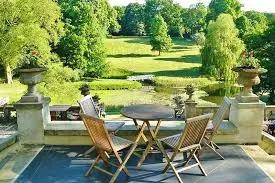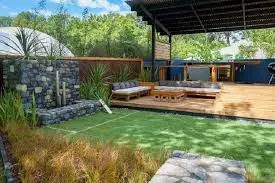10 Low Maintenance Landscaping Ideas for Any Budget
Landscaping is a complicated task, especially if you are unfamiliar with the field. Even if you are starting from scratch, you can still create a beautiful yard. You no longer need to spend thousands of dollars to create a beautiful outdoor space. With a little creativity and some thoughtful planning, you can transform your yard into a functional and aesthetic paradise. This guide will show you simple landscaping design tips that anyone can use, no matter your level of expertise.
1. Start with a Plan: Sketch It Out
Before you start buying plants or digging the ground, you should thoroughly and thoughtfully plan your landscape design. A well-thought-out plan will save you time, money and disappointment later on. Here we will share proper and planned information so that you can get off to a very good start:
Assess your space: Take a good look at your yard. Which areas get the most sunlight? Are there any slopes, trees, or existing plants that need to be considered? Understanding the contours of the land is important to creating a functional design.
Sketch your ideas: You should make a simple sketch of your yard. Include areas in the sketch where you want grass, garden beds, paths or a patio. Think about how you will use the space, whether it is for recreation, gardening or play.
Consider your style: Whether you want a modern, minimalist landscape or a more natural, cottage-style garden, think about how your landscape design will complement your home's architecture and your personal style.
What Is The Cheapest Landscaping Option
2. Choose the Right Plants for Your Climate
One of the biggest mistakes beginners make is choosing plants that are not suited to their climate. This can lead to a lot of disappointment and even death of the plant. To avoid this, choose plants that are native to your area or adapted to your local weather conditions.
Benefits of Native Plants:
Low maintenance: Native plants are adapted to the local environment, so they generally require less water and care.
Support wildlife: Native plants attract pollinators like bees and butterflies, which can help boost your local ecosystem.
Resilient: These plants are more resistant to pests and diseases common in your area.
To find the right plants, visit a local nursery, or check out plant guides specific to your region. You can also consult online resources that provide information based on your planting zone.
3. Use Layers for Visual Interest
One of the easiest ways to add depth and dimension to your landscape is by layering plants. Think of your landscape like a painting, with background, middle, and foreground layers.
How to Create Layers:
Tall plants in the back: Use trees, large shrubs, or tall ornamental grasses to form the background layer. These provide structure and anchor the space.
Medium plants in the middle: Place medium-sized shrubs, flowering plants, or smaller ornamental grasses in front of the taller plants. This creates a transition from tall to short.
Short plants in the front: Finally, plant low-growing flowers, ground covers, or border plants along the front of your garden beds.
Layering not only adds visual interest but also maximizes space by allowing you to use plants of varying heights without overcrowding the area.
What Is The Best Way To Get Started In Creating A Landscape
4. Mix Hardscapes and Softscapes
For a balanced and harmonious design, it’s important to combine both hardscapes (non-living elements) and softscapes (living elements). This blend creates a more complete and functional landscape.
Hardscapes:
Patios and decks: These provide a space for outdoor living and entertaining. Choose materials that complement your home’s exterior and your overall design theme.
Walkways: Pathways help define the layout of your yard and create a flow between different areas. Stone, gravel, or pavers are popular choices.
Retaining walls: If your yard is sloped, retaining walls can create usable flat areas and add texture to your landscape.
Softscapes:
Trees and shrubs: These provide shade, privacy, and structure to your yard. They’re also key for adding year-round interest.
Flowers and ground covers: Use these to soften the edges of your hardscapes and add color and life to your garden.
By thoughtfully combining these elements, you can create a landscape that’s not only beautiful but functional too.
What Is The Cheapest Ground Cover Option
5. Focus on Year-Round Appeal
When planning your landscape, it’s easy to get caught up in the excitement of spring and summer blooms. However, for a landscape that looks good all year, you need to think beyond the growing season.
Tips for Year-Round Interest:
Evergreens: Incorporate evergreen trees and shrubs, which retain their leaves or needles throughout the year. These provide a constant source of greenery, even in winter.
Winter interest plants: Some plants, like red-twig dogwood or holly, offer colorful bark or berries in the winter months.
Ornamental grasses: These add texture and movement to your garden and often look great well into fall and winter.
By selecting a variety of plants that offer interest in different seasons, you’ll ensure that your yard looks attractive throughout the year.
6. Keep Maintenance in Mind
It’s easy to get carried away with an elaborate design, but remember that every plant you choose and feature you add will require some level of maintenance. Before committing to your landscaping plans, consider how much time and effort you’re willing to put into upkeep.
Low-Maintenance Landscaping Tips:
Choose perennials over annuals: Perennials come back year after year, saving you the effort of replanting each season.
Opt for drought-tolerant plants: If you live in an area prone to drought, select plants that can thrive with minimal watering.
Use mulch: Mulching your garden beds helps retain moisture, suppress weeds, and reduce the need for constant maintenance.
By designing with maintenance in mind, you can create a beautiful yard without spending all your weekends working in it.
7. Incorporate Outdoor Lighting
Outdoor lighting is an often-overlooked element in landscape design, but it can have a big impact on the overall look and functionality of your yard. Lighting not only extends the usability of your outdoor space into the evening but also adds safety and ambiance.
Outdoor Lighting Ideas:
Pathway lights: Line your walkways with small lights to create a safe and welcoming path.
Spotlights: Use spotlights to highlight key features in your landscape, like trees or garden sculptures.
String lights: For a more casual and cozy atmosphere, hang string lights around your patio or outdoor seating area.
By incorporating lighting into your landscape, you’ll be able to enjoy your yard day and night.
What Is The Cheapest Grass Option
8. Add a Focal Point
Every good landscape design has a focal point—something that draws the eye and anchors the space. This could be a large tree, a garden sculpture, a water feature, or even a carefully placed seating area.
How to Choose a Focal Point:
Size: Make sure the focal point is large enough to stand out but not so big that it overwhelms the space.
Location: Place the focal point in an area where it can be easily seen from multiple angles, such as the center of a garden or at the end of a pathway.
Style: Choose a focal point that complements the overall design of your landscape. For example, a modern sculpture might work well in a minimalist garden, while a rustic bench would be better suited to a cottage-style yard.
A well-placed focal point can serve as the centerpiece of your design and help guide the rest of your landscaping choices.
9. Use Water Wisely
Water is a crucial element in any landscape, but it’s important to use it efficiently. Whether you’re trying to reduce your water bill or live in an area with water restrictions, there are several ways to create a beautiful landscape while conserving water.
Water-Wise Landscaping Tips:
Install a drip irrigation system: Drip irrigation delivers water directly to the roots of your plants, reducing waste and ensuring they get the moisture they need.
Group plants with similar water needs: When designing your garden beds, group plants that require similar amounts of water together. This makes it easier to manage watering and prevents over- or under-watering.
Collect rainwater: Installing a rain barrel allows you to collect and store rainwater for use in your garden.
By being mindful of water usage, you can create a sustainable landscape that thrives even in dry conditions.
10. Personalize Your Space
Finally, don’t forget to add your personal touch to your landscape design. Your yard should be a reflection of your style and personality, so feel free to get creative and incorporate elements that make you happy.
Ways to Personalize Your Landscape:
Add art: Garden sculptures, wind chimes, or mosaic stepping stones can add personality and charm to your yard.
Create a cozy seating area: Whether it’s a hammock, a bench, or a set of outdoor furniture, having a comfortable place to sit and enjoy your yard is key to making it feel like home.
Plant a kitchen garden: If you enjoy cooking, consider dedicating a space for herbs, vegetables, or fruit trees. Not only will this add beauty to your yard, but it will also provide fresh, homegrown ingredients for your meals.
Personalizing your landscape ensures that it feels like an extension of your home and a place where you can relax and unwind.
10 Low Maintenance Landscaping Ideas for Any Budget
Conclusion
Designing a beautiful landscape doesn’t have to be complicated or expensive. By following these simple tips starting with a plan, choosing the right plants, mixing hardscapes and softscapes, and adding your personal touch you can create an outdoor space that’s functional, visually appealing, and suited to your lifestyle. Whether you






.jfif)

0 Comments